(And it’s not even the Lenten season yet.)
Just one week ago today, I wrote about my Winter walks in wacky weather. One of the highlights in that post were the images I captured of Mallard ducks feasting on the dead fish, (a/k/a Gizzard Shad), that had surfaced in the Ecorse Creek after a freeze/thaw cycle. We’ve had some roller coaster weather here in Southeast Michigan during the last month, beginning with brutal temps, followed by a few warmer-than-normal days, sometimes a mere 24 hours later, before we returned to the Deep Freeze again.
So, whatever is going on weather-wise in 2022, with global warming/climate change as the likely culprit, the annual “shad die-off” is NOT an abnormal event, nor is it happening due to climate change, but it has occurred much earlier in this Winter season.
According to the Michigan Department of Natural Resources, the annual shad die-off is a natural phenomenon that is found in rivers and creeks and nothing to be alarmed about. In fact, there is usually an annual news story with photos as a public service announcement. In the past, the Michigan DNR has suggested you contact them if you see more than 50 shad. You can read about the Gizzard Shad die-off in this news article.
Suffice it to say, the multitude of dead shad and nearby Mallards fascinated me, so these new images will be the subject of today’s post.
Wall-to wall-fish.
Last weekend was bitter cold and I shared some photos taken at Dingell Park at the Detroit Riverfront, which is just 1½ miles away from Council Point Park. So, if a deep body of water with a swift current such as the Detroit River, would be that frozen, you can bet the small Ecorse Creek at Council Point Park would similarly be frozen over. And, in case you were wondering about the fate of the many turtles at this venue in this cold weather, they have been hibernating beneath the mud since October and won’t emerge until March or April when the temps warm up.
As to last week’s post … some of you were amused by the ducks wrangling and devouring (or at least trying to) the dead shad and still others were astounded to learn that ducks were omnivores, not just herbivores.
The very morning that post published, I went to Council Point Park. It was still bitter cold and surprisingly the water in a small alcove near the sewer drain had warmed up enough to thaw the ice, once again exposing dead shad. There were hundreds of shad bodies – more than I’ve ever seen at one time and the Mallards were standing nearby on the ice – were they guarding their food source?
While I usually take my camera along when I walk, because it was bitter cold and a work day, I decided to forego any pictures. I wanted to give the car a brief run, thus skipping the walk in the ‘hood, intending to double up on my steps along the perimeter path instead. So, I cursed myself for not having the camera handy as this scene would be a great way to illustrate one of the largest “fish kills” I’ve seen in the nine years I’ve been walking at this venue.
At the risk of using teen lingo, yes – the scene was “gross” but, the fish were perfectly preserved and there was no fishy smell.
So, I jumped in the car, drove home, retrieved the camera and returned about 15 minutes later.
Lady – curb your enthusiasm … it’s just fish and we’re fish-eating ducks!
So I hustled over to the ledge and whew … the scene was the same as when I left it, with about 25 to 30 Mallards sitting on the ice gazing at a small alcove that was jam-packed with frozen fish. I took these shots so you could see just how many fish were there in the foreground. The ducks were on a ridge of ice and behind them the Creek was still frozen and speckled with splotches of snow.
Next, I edged nearer to the ledge in an effort to get some up-close pictures of the Mallards.
Then, greedy for even more close-ups, this time for the shad, I stepped down onto the actual cement ledge that overlooks a sewer drain. Here’s what the ledge looks like.
And here are close-ups of the shad …
… then I noticed some bubbles in the water and realized some live shad were flip-flopping around with their fallen brethren. Yikes!
It was all good until I heard a cracking sound – no, the cement ledge was not breaking, but the piece of ice with the weight of all the ducks cracked – this sudden noise spooked the ducks.
One duck, startled, prepared to take flight …
The other ducks were similarly spooked, panicked and went airborne and headed in my direction. Yes I DUCKed, but there was a moment of fear that they’d fly into me and knock me into the water as I was precariously close to the edge. That would have been a fine kettle of fish had I landed in the icy cold Creek, especially since I don’t know how to swim! (Note to self – going forward, no matter how great you think the shot will be, don’t get so close to the water!)
In the end, neither the camera nor me were any worse for the wear since Your Roving Reporter apparently posed a greater threat than the crack in the ice. The Mallards did a hasty about-face and returned to their icy perch.
A few more of the Mallards decided to plunge into the shad-laden water and grab a snack …
… giving a twist to the old mobster expression of “swimming with the fishes.”
Shadapalooza.
What better name to call this occurrence? My final photo of the morning was this lone, red angler’s bobber that gave a pop of color to the wall-to-wall fish.



















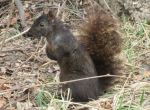


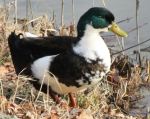







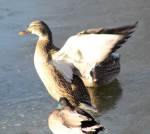

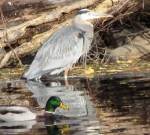




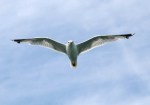


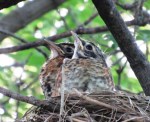








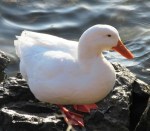


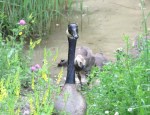













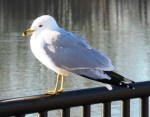



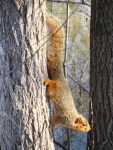









Wow, sounds more like a fish kill from some toxic substance than a recurring event, Linda, but if it’s an annual thing then I guess that’s what momma nature intended, but what a sight! The ducks 🦆 were good for weeks with that cache. What happens to the fish that don’t get eaten? And the bones?
LikeLiked by 1 person
Hi Pam – I have never seen a fish kill this large nor this early in the season, but the reason the shad die-off (and other fish don’t) is because they have a poor tolerance of cold Winters and fluctuating temperatures. According to what I have read about the shad die-off, as many as 90% can die during a natural die-off. That’s a good question you pose Pam – I think the seagulls and other waterfowl eat them whole. In late December there were seagulls everywhere, buzzing overhead and sitting on the water like ducks and they eat on the spot and/or carry off the live shad. Occasionally they will drop one on the pathway. I suspect they swallow them whole. As for the fish that don’t get eaten, the Creek flows down to the Detroit River, so that it is such a large body of water with way more waterfowl, that they likely pick over the remains. I sent the post to the DNR to show them the large die-off, but I’ve not heard back from them.
LikeLiked by 1 person
Wow and wow! That’s all news to me, Linda.
LikeLiked by 1 person
Nature is fascinating isn’t it Pam?
LikeLiked by 1 person
Yes it is, Linda. 😎🥸
LikeLiked by 1 person
Oh my – this is a very large amount of fish. I was worried you might end up in the water and no one would come by to rescue you. Perhaps close-ups of the Ducks is unadvisable in this situation. You did capturer some fantastic pictures. Be careful out there girl!
LikeLiked by 1 person
Yes, it is a lot of fish Peggy and most of this group of fish drifted downstream after we had a one-day thaw again plus very high winds. I will avoid getting that close to the water again – I really had a moment of fear as they flew toward me. If you ever see ducks get startled, they don’t take off in an orderly fashion – they all leave at once in a helter skelter fashion. I often go down onto the sewer drain and stand on the ledge to get pictures of the heron across the Creek, but I won’t go there if it’s windy. I didn’t expect those ducks to become startled and all take off together. Now I don’t think I’ll go there anymore. I find the fish kill interesting – yes not the prettiest pictures, but fascinating to see.
LikeLiked by 1 person
I have seen Ducks take off. I believe having them come straight for you could be hazardous to one’s health and well being. The wind can be quite dangerous under the right conditions. Was amazed by the picture of so many fish in one spot.
LikeLiked by 1 person
Yes, they all go at one time … I’ve been at Heritage Park, (the park with the man made lake and the covered bridge), and all of a sudden a Mallard will act up and get in a fit about something. They all get spooked and fly out of the water to land all together somewhere else nearby – guess they dislike confrontation. 🙂
LikeLiked by 1 person
I have not been around the Mallard Ducks much, but I have seen pairs fight with each other. Domestic violence. Ha
LikeLiked by 1 person
Yes, and sometimes two males fighting for one female’s attention … do you ever see the Canada Geese or the Mallard Ducks rise out of the water and go after the other. They are flying low on the water, but chasing the other duck or goose and making quite a ruckus in doing so.
LikeLiked by 1 person
Yes, I have seen them rise out of the water to chase and fight with each other. The Trumpter Swans do this too.
LikeLiked by 1 person
The thing that is so fascinating is it happens so fast – sometimes I see them paddling along, then in a heartbeat, I see wing flapping and hissing or chasing one another. 🙂
LikeLiked by 1 person
This is a fun post. Can you imagine wading through your favorite snack??? I’d be knee-deep in chocolate.
LikeLiked by 1 person
Glad you liked it Anne. I found the whole fish die-off fascinating as there were so many of them. Usually there are maybe 50-100 the entire Winter and those are along the banks of the Creek or an occasional one floating in the Creek – nothing like this. I can’t imagine wading through the fish – it’s not too appetizing and yes, knee-deep in chocolate would be the ultimate treat!
LikeLiked by 1 person
I find these photographs fascinating!
LikeLiked by 1 person
Glad you liked the photographs Anne. I was amazed and had to go get the camera as I’ve never seen a shad die-off like this before … at the most 50-100 bodies at the Creek banks, but nothing like this!
LikeLiked by 1 person
Oh … this is very … erm … unusual to see. Love the tilte Linda!
LikeLiked by 1 person
Yes, amazing and a little spooky at the same time. At least they look perfectly preserved Jeanine. Glad you liked the title too!
LikeLiked by 1 person
It was really rather strange. Swimming with your dead kin … but I guess some other animals would have fun with that?!
LikeLiked by 1 person
Hmm – I think my reply must have gone to your SPAM – something fishy with that as I didn’t think I was SPAMMY. 🙂 I see some strange things but I have to admit that this was the strangest I’ve seen in a long time.
LikeLiked by 1 person
Fishy! ha ha ha!!
LikeLiked by 1 person
🙂
LikeLike
I like the startled duck photo. You captured his surprise and it makes me smile. I didn’t realize how many shad died at the same time. Fascinating photo of them under the ice. It looks like it could be some funky wallpaper.
LikeLiked by 1 person
Thank you Ally. I was happy to get at least one photo of the duck preparing for liftoff with wings spread and on his tippy-toes. If I hadn’t panicked when they all came toward me, I might have got more pics of them in flight. I didn’t want to end up alongside that red bobber! The frozen fish under ice were a little odd looking and I couldn’t help wondering if the brown marks on them were freezer burn? 🙂
LikeLiked by 1 person
Wow! I like the pictures of the single duck and the duck pair swimming in the midst of all the fish, dead or dying. Also the close-ups of the shad. I’m glad you got the pictures but am relieved you didn’t fall into the icy cold water. You did a great job of explaining and capturing this unique and interesting natural phenomena for us to see!
LikeLiked by 1 person
Glad you liked the photos Barbara. I was excited to see that big group of fish and the ducks, especially after other bloggers were in awe over over the ducks eating the fish last week. I knew the pics would be amazing to see. It sounds a little gory to take such photos, but the fish looked okay, so I figured I’d go for it. I couldn’t decide which of those single duck and pair swimming in the fish to use for a header, so I went in another direction and used the frozen fish instead. Glad you enjoyed reading about another one of nature’s quirks.
LikeLiked by 1 person
Good heavens…nature Really can be rather macabre…it must rot surely…
LikeLiked by 1 person
It was pretty amazing to see Michael. Every Winter, at the most there are maybe 50-100 dead shad and the waterfowl usually eat them while it is still cold out, or they wash up to the shoreline, so they don’t smell nor rot as you might suspect.
LikeLike
Lucky old gulls!
LikeLiked by 1 person
The gulls won’t be trying to swipe food from people for a while. 🙂
LikeLike
You mentioned this is a yearly event and so must be natural. I’m not convinced of that? With it being so close to a outfall pipe,It looks suspicious?
I suggest all of the organic matter being deposited by this outfall pipe is consuming all the oxygen (DO, dissolved oxygen) and basically suffocating the fish?
The fish congregate here (naturally) because it is a warmer spot. The cold waters herd them into this kill zone. For survival they sense warmer waters and swim to this spot.
Humans once again (indirectly this time) are altering and so are killing these fish.
I believe this pipe to be a grey water outfall and not sewage? Raw sewage is not dumped without treatment.
LikeLike
Well, there are other fish that live in this Creek though Wayne. I took a photo of a guy who landed a large yellow Carp a year or so ago and there are always huge Carp jumping out of the water in the Spring. The fisherman (Jacob) that I’ve mentioned before, catches a lot of fish, sometimes these. According to the articles about this shad die-off, it is because these small fish cannot tolerate the cold temps, then rapidly fluctuating to warmer temps and they are prolific breeders and as much as 90% of them die off every year. I sent the link to the blog post to the DNR so they can see just how many shad died this year.
LikeLike
Why did they surround this outflow area?
Don’t you find that odd?
Not all fish are the same. Some fish cannot tolerate low DO, which appears to be the Shad.
It does look like these fish have an aversion to cold cold water. These fish were herded by the cold to a spot where there was warmer water. That warmer water was coming from the street runoff. If they use salt on the roads I would also suspect the salt content would be much higher as well?
LikeLiked by 1 person
We’ve had a lot of rain the last two years. The water level in the drain is much higher than it ever was before. You can see the size of the drain from the cement ledge that sits over it – it is a big drain and when I first started walking there, the water never froze inside and all the ducks used to stay in the water under the drain all Winter, but now, their heads are near the top of the drain and they no longer swim inside like before. I never understood how the water doesn’t freeze in there – maybe because the cold air doesn’t penetrate the water there? I don’t think there is enough salt from the perimeter path (they had plowed and salted it) to run into the water, but I could be wrong, but I do know that when there are flooding issues, they allow some sewerage to flow into this Creek and that flows down to the Detroit River, so any street salt would be going into the sewer drains as well. It said in the article that shad have a low tolerance for fluctuating temperatures, so that is what I guess they died off … we have had some wildly fluctuating temps in late December and in January so that has to be the reason.
LikeLiked by 1 person
In this article they suggest the Shad survivability increases when the water is completely iced over. So maybe because this water coming out is warmer the ice doesn’t completely ice over leaving the Shad vulnerable?
https://www.in-fisherman.com/editorial/science-of-shad-winterkill/153824
LikeLiked by 1 person
That was interesting Wayne and I know this is very early for this to happen – it is more like Spring when the big thaw begins and never this many, just 50-100 tops. This story is right because we did not have prolonged ice on the Creek. We’d have very cold weather for a few days, then have a 40-degree day and and a thaw. In a normal year, we would have the frozen Creek and it stayed frozen most of the Winter. Interestingly, in the Facebook forum for our City residents, someone said they saw a man and kids on the Creek ice yesterday and told them it was not solid and to get off it immediately – within moments of that comment, others commented that they had skated on a frozen Creek for years, but now the current ice should not be trusted. So the change in temps caused their death more than the solid ice/lack of oxygen. Did you notice the brown marks on the up-close fish … I had wondered if that was a type of freezer burn because some of them may be attached to the ice?
LikeLiked by 1 person
So many fish, wow, that is so strange. I am thinking what Wayne said might be true. That is to bad. It is hard to imagine still that the ducks don’t go south for the winter. 🙂
LikeLiked by 1 person
The DNR and other scientists say this is a natural occurrence Sandra. I think it is earlier in the season this year though, so perhaps this is why there are so many. This usually happens closer to Spring. Apparently the shad are not able to last through the fluctating cold, then warm temps and they die off.
LikeLike
It is both amazing and disturbing, here we have the environment agency which you can report issues too and at least there would be a definitive answer to if a natural occurrence or an environmental pollutant.
LikeLiked by 1 person
I know Andy – it is amazing to see the pictures and the enormity of such a large group of dead fish. The Department of Natural Resources usually has a public services announcement not to worry if you see the fish and to report if you see over 50-100 dead shad. I sent a link of this blog post to the Michigan DNR to alert them to the overabundance of shad.
LikeLiked by 1 person
be intresting to see their reply.
LikeLiked by 1 person
I’ve not heard back from them yet Andy. I sent them a direct message via Facebook as I think the website may not allow me to send a link. I will let you know what I hear.
LikeLiked by 1 person
Hi Andy – just to update you, I sent the direct message on Facebook on Monday and it was viewed today at 12:38 p.m. but I did not get a response.
LikeLiked by 1 person
The amount of shad in those photos is crazy!!! I have never seen a fish kill like that. Great job, roving reporter. You taught me something new today.
LikeLiked by 1 person
I know Laurie – neither have I and I was amazed to see it. I knew it would be a good follow-up story to the ducks eating fish last week. Thanks – it was fun taking those pictures until the ducks got spooked. I learned from researching that shad cannot withstand the fluctuations in temperatures and though they have a large population, they also have a high die-off rate (90%). That’s incredible to me too.
LikeLiked by 1 person
That’s a lot of dead fish!
LikeLiked by 1 person
It was amazing to see Kate. Since the dead fish looked okay and weren’t really gory looking, it would make an interesting follow-up to last week’s photos of the ducks devouring the shad.
LikeLiked by 1 person
I don’t think the ducks will go hungry. You got some really nice photos of this event!
LikeLiked by 1 person
I think you’re right about that Rebecca – I wonder if those fatter-than-usual ducks caused that ice to crack? Thank you – glad you liked the photos. It was fun seeing this up close and taking pictures. The fish were well preserved and jam-packed as they were, it looked a little like a fish market!
LikeLiked by 1 person
Miss Linda…………………………………..your story on the ducks and dead fish is amazing………………………..I’ve never seen it before……………………….and that ducks are omnivorous……….also………………………….you’re a great reporter ………………………also!!
LikeLiked by 1 person
It was really something to see Ann Marie, so I’m glad I could get photos to put into a blog post … that was a first for me. Glad you like my reporting skills too. 🙂
LikeLike
I have never seen anything like this before! SO many fish! x I imagine it was a good day for the ducks though. It’s an all you can eat buffet! xxxx
LikeLiked by 1 person
I like that idea Heather – that’s exactly what it looked like. I’ve never seen anything like it either. Just amazing. And the ducks didn’t seem to mind swimming through their meal.
LikeLiked by 1 person
You do capture some fascinating events with that camera of yours. That certainly is a lot of dead fish! Certainly is some misperception about mallards, including that they don’t dive (I have indeed seen them diving). I do believe that the turtles are estivating.
LikeLiked by 1 person
Thank you Eilene – this fish kill fascinated me as it was so large. I usually know the shad are running when the seagulls are buzzing around or sitting on the water gobbling them up; then after the freeze/thaw, I’d usually see 50-100 tops along the shoreline. Nothing like this – it just astounds me. I’ve seen dabbling ducks, but not diving ducks. I’ve seen a Cormorant diving though – if the water is clear enough you can see it go down and resurface much farther away and they go fast! I’d never heard of estivating, so I looked it up – I had heard of torpor. I took some interpretive walks at the Metropark and they showed how crayfish go into torpor and did mention turtles as well.
LikeLiked by 1 person
This is so crazy! I have never seen anything like this, that is a ton of fish. You said the turtle’s weather under the mud for the winter, I wonder how they get air?
LikeLiked by 1 person
Turtles metabolism slows down in winter and they can breath through their skin.
LikeLiked by 2 people
I wasn’t sure Tom so thank you for the info for Diane and me. I knew they buried under the mud/silt. I took an interpretative walk at the Metropark and they explained how the crayfish and turtles do this and go into a state of torpor and snakes do not and can be seen slithering, albeit slowly, and even sunning themselves in Winter.
LikeLike
Thank you Tom!
LikeLiked by 1 person
It is amazing isn’t it Diane? And I was down there last Saturday taking pictures in the Park and there was still “a sea of shad” plus a group of them had drifted down the Creek in a big group as it was windy and we’d had a one-day thaw. I saw that Tom has answered you that they breathe through their skin. I didn’t know that, but I knew they bury themselves under the mud/silt until it is warmer. The fish need to have a Plan “B” it seems. 🙂
LikeLike
Well, Linda, it’s duck heaven for sure! 😁
Thursday, i am buying raw peanuts and going to my mother-in-law’s assistive living place. Last week, i saw squirrels in the enclosed courtyard (outside her window) and they kept going into glass feeders that were empty. The hospital that runs the place had told us that we cannot bring food for the animals there, but i made my case… and a few days later, they called me and said that i could bring peanuts. So i will. You’d be proud of me!
On a sadder note, my sweet, little dog, Lola, passed today. I sure will miss my sweet little girl. 🐶
LikeLiked by 1 person
I just replied and my comment went into cyberspace again … I don’t understand it. I am proud of you Tom for championing the squirrels’ cause and also pointing out “past practice” … those squirrels are going to appreciate those peanuts on a cold day … you might be similar to our weather which will be hovering around zero in the morning.
I am sorry to hear about Lola Tom – you weren’t expecting it as she seemed to rally back from the heart medication. I am sorry for your loss – your devotion to her contributed to her having a long life.
LikeLike
That is a crazy number of dead fish….but I’m wondering why they die off like that? Sorry, it’s late and I didn’t read the article, I’ll go back and read it tomorrow.
LikeLiked by 1 person
I did read it but it didn’t really address why? Also if they normally die off in April then wouldn’t it smell fishy in the warm spring sunshine?
LikeLiked by 1 person
There is no oxygen due to the Creek icing over so they die – I don’t know why a few of them were still alive, but barely. Maybe in an air pocket? But they weren’t 100% lively either – some were swimming sideways and others doing the backstroke. Every year, when the ice thaws and exposes the dead fish, they don’t smell as they have been in the cold water, so they’re preserved. Also, I don’t know if you can tell, but the ledge is not near the walking path – you have to go down a hill to get there, then walk onto the ledge, so even if the fish smelled because it was a warm day, they are far from the perimeter path.
LikeLiked by 1 person
Thanks for explaining that Linda!
LikeLiked by 1 person
You’re welcome Joni!
LikeLike
Yes, usually just about 50 to 100 every year and they are floating along the shoreline in March or early April, depending on how quickly it warms up. This year it was cold than warm several times and it caused the freeze-up earlier … not a solid freeze-up as it was cold for several days, then up to the 30s, even the 40s. I’ve never seen such a huge die-off before. Pretty amazing to see how jam-packed those dead fish really are.
LikeLiked by 1 person
fantastic post, Linda, and not something we see everyday
I enjoyed the way you led us into the closes ups and then even the red bobber
—
also, good to know that shad die-off is a normal occurrence, but it sure is freaky and I am glad you went back and got your camera – this was a great share and your photo journalism is insightful
LikeLiked by 1 person
Thanks Yvette – I was really fascinated by this shad die-off, even though I see it every year, but always in the Spring and to a much-lesser degree than this. I tried to show just how many shad there were with the wall-to-wall shot, so thank you … I am glad you liked that and also how I showed a far-away perspective, then up-close. I am always angry with myself if I decide I will not be taking photos as it’s too cold or it might rain/snow and find something photo-worthy. Grrr!
LikeLiked by 1 person
🙂
LikeLiked by 1 person